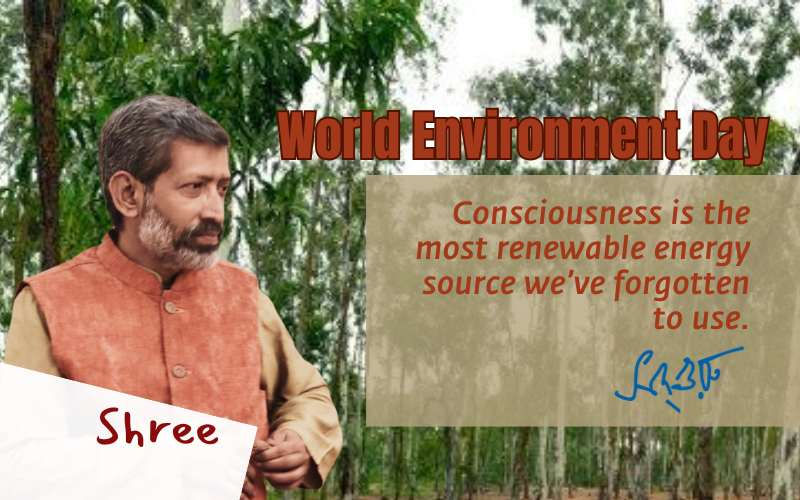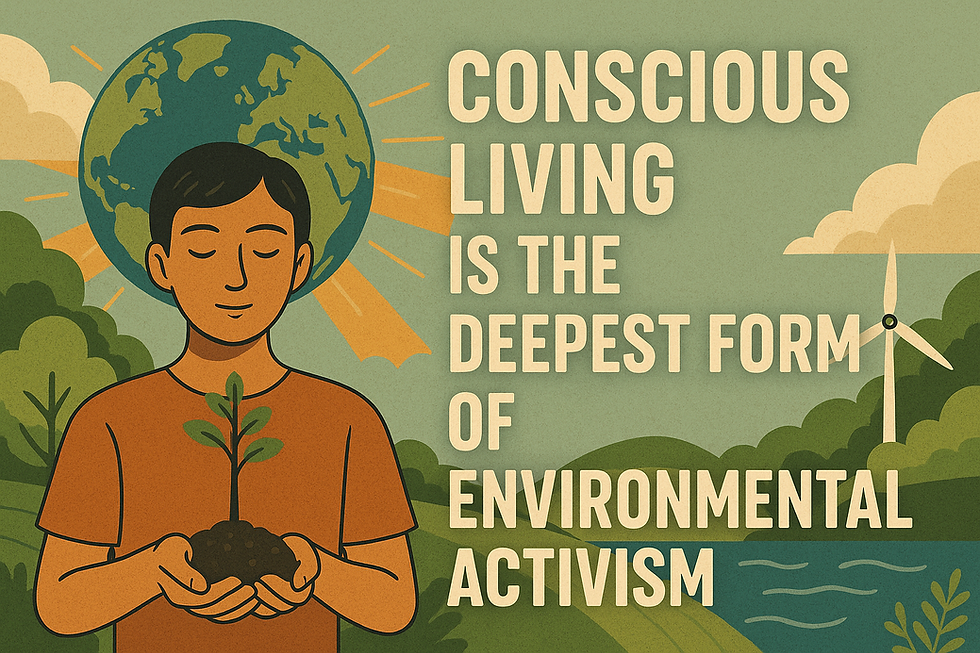Conscious Living is the Deepest Form of Environmental Activism - Sadhguru
- Sadhguru

- Jun 5
- 5 min read
Sadhguru says Conscious living is the silent anthem of the Earth’s revival. To live with awareness is to breathe with the planet, not just on it. Consciousness is the most renewable energy source we’ve forgotten to use. You don’t need to carry a placard—just carry awareness into every choice.

Article | Shree Siddhashram | June 06, 2025

Sadhguru: ~ A Journey from Awareness to Planetary Awakening
The Crisis We Can No Longer Ignore
We stand at a critical juncture in the evolution of human existence—where nature's patience is wearing thin, and the consequences of human negligence are echoing louder than ever before. Climate change, pollution, deforestation, biodiversity loss, ocean acidification, and the mass extinction of species are not distant threats—they are here and now. But amid this crisis emerges a truth, often overlooked: environmental destruction is not just a political or technological problem; it is a reflection of human unconsciousness.
This is where conscious living enters—not as a trend or a practice, but as a radical act of environmental activism. It is activism not through slogans or marches alone, but through every breath, bite, choice, and moment lived in awareness. It is a rebellion against mindless consumption, against habitual pollution, against the numbing of our ecological empathy. It is a path of deep sensitivity, where each individual becomes a guardian of the Earth—not with protest signs, but with inner revolution.
Part I: Defining Conscious Living
What is Conscious Living?
Conscious living is the art and discipline of aligning one’s daily life—thoughts, choices, consumption, actions, and habits—with awareness, responsibility, and compassion. It means living intentionally, not reactively. It involves questioning where your food comes from, how your clothes were made, what your waste does to the environment, and how your presence contributes to or depletes life around you.
In the context of environmental activism, conscious living is a holistic path—it's not about doing something for the planet once a year, but about becoming someone who lives in harmony with the planet every day.
Principles of Conscious Living:
Mindful Consumption – Every product you use affects ecosystems and species. Conscious living asks: “Do I really need this? What is its environmental cost?”
Compassionate Awareness – Extending your empathy beyond human beings to rivers, trees, animals, air, and the soil.
Minimalism – Living with what is necessary, reducing waste, decluttering the planet and mind simultaneously.
Sustainability – Choosing renewable, organic, local, biodegradable, and ethical alternatives.
Presence and Purpose – Acting with full presence, knowing your daily life is a message to the Earth.
Living consciously is refusing to participate in the destruction of our only home.
Part II: The Myth of External Activism
In a world dominated by external metrics—protests, speeches, and policy changes—internal revolutions are often underestimated. But let’s face a simple truth: policies change, but culture remains stagnant if individual consciousness doesn’t evolve. Technology can reduce emissions, but it cannot eliminate the greed that fuels overproduction. We can pass climate laws, but if billions of people still live unconsciously—throwing plastic, wasting water, eating factory-farmed meat, supporting fast fashion—then the Earth will continue to bleed.
Activism must be internalised. Without that, external activism is like treating cancer with makeup. This is where conscious living as environmental activism takes root.

Part III: The Inner Ecology
The Link Between Inner Pollution and Outer Pollution
Our external environment is a mirror of our inner state. A restless mind produces restless actions—leading to overconsumption, waste, and aggression toward nature. A silent, centred mind radiates care, balance, and empathy.
Every plastic bottle used unconsciously is born out of a distracted mind. Every tree cut down without remorse stems from a desensitised heart. Thus, cleaning the Earth begins with cleaning consciousness.
One mindful choice can silence a thousand acts of unconscious harm.
Spiritual Ecology: A Forgotten Dimension
Indigenous cultures across the globe understood something modern society has forgotten—that the Earth is not a resource but a living spirit. Ancient Vedic, Taoist, Native American, and Aboriginal wisdom systems revered the Earth as sacred. Conscious living, therefore, is not just environmentally beneficial; it is spiritually essential.
When you live consciously, your food becomes a prayer, your breath becomes an offering, and your lifestyle becomes a ritual of gratitude.
The planet doesn’t need saviours—it needs aware humans.
Part IV: Everyday Acts of Silent Environmental Revolution
Let’s move beyond theory into practice. How can conscious living become the deepest form of environmental activism in practical, daily life?
1. Food as Activism
Eating local, seasonal, organic food supports ecosystems and reduces carbon emissions.
Choosing plant-based meals reduces deforestation, water use, and cruelty.
Composting food waste returns nutrients to the Earth.
“What you eat today either nourishes the Earth or depletes her. Conscious eating is conscious living.
2. Fashion as Activism
Say no to fast fashion that destroys rivers and exploits labour.
Buy fewer, better clothes; wear them longer.
Choose sustainable fabrics: organic cotton, hemp, and bamboo.
3. Energy as Activism
Turn off unnecessary lights, appliances, and fans.
Embrace solar, wind, and renewable energy sources.
Avoid electronic addiction—save power and reclaim mental clarity.
4. Waste as Activism
Carry your own water bottle, bag, and cutlery.
Segregate and recycle religiously.
Reduce bathroom and kitchen plastic.
5. Transportation as Activism
Walk or cycle when possible—good for the planet, body, and soul.
Carpool or use public transport.
Offset travel emissions with tree-planting or eco donations.
6. Digital Minimalism as Activism
Each email, search, or scroll consumes energy. Be mindful.
Reduce screen time; increase real presence.
Real change isn’t explosive; it’s conscious, consistent, and quiet.
Part V: Children of the Earth – Raising Conscious Generations
Children are not just inheritors of the Earth—they are co-creators of its future. Conscious living extends into parenting, education, and culture. Raising children with eco-awareness, empathy for animals, connection to nature, and joy in simplicity lays the foundation for a regenerative world.
Let children:
Play in mud.
Plant trees.
Read stories of the Earth.
Observe bees, butterflies, and birds.
Question where things come from and where they go.
This is activism without a flag, but with a future.
Part VI: The Role of Silence in Sustainability
The world is loud with consumption and clutter. But silence heals.
When we cultivate silence through meditation, nature-walking, or breath awareness, our desires shrink, and clarity rises. We begin to understand that fulfilment doesn’t come from things, but from being. This is crucial because consumerism is the root of ecological collapse.
“The quieter the mind, the greener the life.”
Part VII: Conscious Communities – The New Earth in the Making
Conscious living isn’t solitary. When communities awaken, ripples become waves. From eco-villages to permaculture farms, from sustainable schools to urban rooftop gardens—the world is slowly shifting. Each conscious individual adds energy to the collective transformation.
Imagine:
Streets where zero-waste shops thrive.
Cities powered by solar and silence.
Schools teaching mindfulness before math.
Governments are prioritising well-being over GDP.
It all begins with you.
Conclusion: From Activist to Earth Mystic
The greatest gift you can offer the Earth is not just money, protest, or a policy—it is your transformed lifestyle. One that says:
I see you, Mother Earth.
I will not harm you for convenience.
I will live gently upon you, like a whisper instead of a wound.
Conscious living is activism in its most sacred, sustainable, and silent form. It does not shout—it breathes. It does not march—it walks with the Earth. It does not divide—it unites the self and the soil.
Call to Action: Begin Here, Begin Now
Start with one act today: skip plastic, walk barefoot on grass, meditate on a tree, eat a plant-based meal, turn off a light.
Reflect before you consume.
Love before you waste.
Breathe before you decide.
You don’t need to save the whole planet. Just stop harming it through unconscious living. That alone is the beginning of a revolution far deeper than protest—a revolution of presence.





